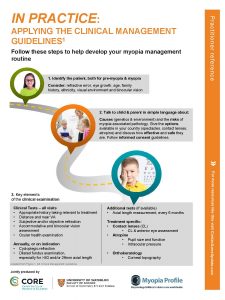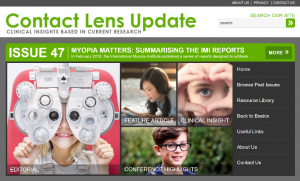Review of Myopia Management to Share Content from Contact Lens Update, and CORE to Contribute Original Articles to Review of Myopia Management

WATERLOO, Ontario, October 30, 2019—The Centre for Ocular Research & Education (CORE) today announced a collaboration with Review of Myopia Management, published by Jobson Medical Information.
The collaboration has begun with Review of Myopia Management sharing content from CORE’s online clinical educational magazine, Contact Lens Update. Now available in the resources section of Review of Myopia Management are summaries of each of the International Myopia Institute (IMI) reports. Authored by members of CORE’s clinical science team, and originally appearing in issue 47 of Contact Lens Update, each provides a short summary key insights and recommendations from the reports. Links to the full IMI open-access papers are also available through both websites.
“The IMI reports were long-anticipated and much needed. In an evolving clinical field such as myopia management, it is of paramount importance that eye care professionals keep themselves informed to offer the best possible evidence-based therapies to their patients,” said Karen Walsh, Clinical Scientist and editor of Contact Lens Update. “The IMI reports contain a valuable summary of that evidence base as it currently stands. Content initiatives through Contact Lens Update and Review of Myopia Management help translate that information into practical advice for use in practice.”
Over the next 18 months, CORE scientists will also contribute original articles on key topics for Review of Myopia Management. Dr. Lyndon Jones, director of CORE, summarized the relevance of the initiative: “Recognising the worldwide epidemic of myopia, we value the opportunity to collaborate with partners such as Review of Myopia Management in order to increase opportunities for practitioners to access and evaluate new research, thinking and techniques.”
Published six times per year, Contact Lens Update provides a global platform for unbiased clinical insights based in current research. Since 2011, each issue has provided dependable and up-to-date ocular health information for more than 60,000 leading eye care professionals.
In addition to a complete archive of back issues, ContactLensUpdate.com offers a resource library that provides no-cost professional tools, patient resources, images, and video. It also houses complementary technical training videos produced by International Association of Contact Lens Educators, plus an industry glossary. Industry professionals can access the latest issue directly from ContactLensUpdate.com or quickly sign up for email receipt of future issues.
The Contact Lens Update receives support from the educational arms of Alcon and Johnson & Johnson Vision.
# # #
About the Centre for Ocular Research & Education (CORE)
The Centre for Ocular Research & Education (CORE) was established in 1988 at the University of Waterloo’s School of Optometry & Vision Science. Over the next three decades, the organization evolved from a three-person operation into a thriving hub of basic and applied research, collaborating with sponsors, agencies and academia on advanced biosciences, clinical research and education. Its uncompromising independence and results of the highest quality have been at the heart of many of the most prominent advances in eye health. Today, its approximately 50-person team serves a range of ophthalmic sectors, including medical devices, ocular pharmaceuticals, digital technology and others, with a focus on the anterior segment. For more information, please visit core.uwaterloo.ca.
MEDIA CONTACTS
Aimee J. Lewis or Mike McDougall, APR, Fellow PRSA, McDougall Communications for CORE
aimee@mcdougallpr.com +1.585.414.9838 | mike@mcdougallpr.com +1.585.545.1815






 According to researchers at the University of Waterloo, while preservative-free drops are best for severe dry eyes, they are not the only option to consider in the management of more mild stages of the disease.
According to researchers at the University of Waterloo, while preservative-free drops are best for severe dry eyes, they are not the only option to consider in the management of more mild stages of the disease. the removal of materials from the eye, such as tiny pieces of metal from the cornea. OcuBall comes premade with carbon/mild steel particles inserted on the surface of the eye to provide a realistic, safe and inexpensive clinical scenario for the practice of foreign body removal. Over time, the metal pieces can rust and form a typical rust ring, just as they do in the human eye.
the removal of materials from the eye, such as tiny pieces of metal from the cornea. OcuBall comes premade with carbon/mild steel particles inserted on the surface of the eye to provide a realistic, safe and inexpensive clinical scenario for the practice of foreign body removal. Over time, the metal pieces can rust and form a typical rust ring, just as they do in the human eye. Over the past few years, a better understanding has been reached of what is happening at the cellular level when this type of staining occurs, and has provided suggestions both for the mechanism by which this occurs and the agents that may be responsible. Novel in vitro experimentation by Tahmina Khan, PhD, contributes recent evidence in this area, highlighted in a
Over the past few years, a better understanding has been reached of what is happening at the cellular level when this type of staining occurs, and has provided suggestions both for the mechanism by which this occurs and the agents that may be responsible. Novel in vitro experimentation by Tahmina Khan, PhD, contributes recent evidence in this area, highlighted in a 



 Optometrists and pharmacists have overlapping areas of patient care—yet formal, practical education about these intersections has been absent. That’s why a team of pharmacists, eye care specialists and curriculum design experts from the University of Waterloo’s
Optometrists and pharmacists have overlapping areas of patient care—yet formal, practical education about these intersections has been absent. That’s why a team of pharmacists, eye care specialists and curriculum design experts from the University of Waterloo’s  “Pharmacists are often consulted for relief of ocular conditions, and in some areas, pharmacists have prescribing authority. Additionally, optometrists are more frequently recommending pharmaceutical products to patients,” said Karen Walsh, Clinical Scientist, CORE and co-author of module one. “Yet the interaction between our disciplines—which could ultimately improve clinical outcomes and patient satisfaction—has been lacking. We’re aiming to change that.”
“Pharmacists are often consulted for relief of ocular conditions, and in some areas, pharmacists have prescribing authority. Additionally, optometrists are more frequently recommending pharmaceutical products to patients,” said Karen Walsh, Clinical Scientist, CORE and co-author of module one. “Yet the interaction between our disciplines—which could ultimately improve clinical outcomes and patient satisfaction—has been lacking. We’re aiming to change that.”